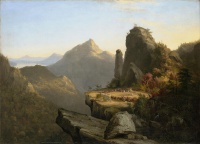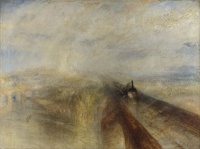19th century art
From The Art and Popular Culture Encyclopedia
| Revision as of 15:55, 9 July 2022 Jahsonic (Talk | contribs) ← Previous diff |
Revision as of 15:56, 9 July 2022 Jahsonic (Talk | contribs) Next diff → |
||
| Line 11: | Line 11: | ||
| {{Template}} | {{Template}} | ||
| + | [[Visual arts]] of the [[19th century]] was characterized by subsequent art movements. Its epicenter was France. | ||
| + | |||
| After [[Rococo]] there arose in the late 18th century, in [[architecture]], and then in painting severe [[neo-classicism]], represented by such artists as [[Jacques-Louis David]] and his heir [[Jean Auguste Dominique Ingres]]. Ingres' work already contains much of the sensuality, but none of the spontaneity, that was to characterize [[Romanticism]]. | After [[Rococo]] there arose in the late 18th century, in [[architecture]], and then in painting severe [[neo-classicism]], represented by such artists as [[Jacques-Louis David]] and his heir [[Jean Auguste Dominique Ingres]]. Ingres' work already contains much of the sensuality, but none of the spontaneity, that was to characterize [[Romanticism]]. | ||
Revision as of 15:56, 9 July 2022
_-_Edgar_Degas.jpg)
|
"The Europeans (2019) interweaves rail transport, the diffusion of cultural products, the histories of copyright, mechanical reproduction, tourism, 19th century literature, art and music with the personal lives of operatic star Pauline Viardot, her husband Louis Viardot and her lover Ivan Turgenev to sketch a remarkably lively portrait of 19th century Europe."--Sholem Stein |

|
Related e |
|
Featured: |
Visual arts of the 19th century was characterized by subsequent art movements. Its epicenter was France.
After Rococo there arose in the late 18th century, in architecture, and then in painting severe neo-classicism, represented by such artists as Jacques-Louis David and his heir Jean Auguste Dominique Ingres. Ingres' work already contains much of the sensuality, but none of the spontaneity, that was to characterize Romanticism.
This movement turned its attention toward landscape and nature as well as the human figure and the supremacy of natural order above mankind's will. There is a pantheist philosophy (see Spinoza and Hegel) within this conception that opposes Enlightenment ideals by seeing mankind's destiny in a more tragic or pessimistic light. The idea that human beings are not above the forces of Nature is in contradiction to Ancient Greek and Renaissance ideals where mankind was above all things and owned his fate. This thinking led romantic artists to depict the sublime, ruined churches, shipwrecks, massacres and madness.
Romantic painters turned landscape painting into a major genre, considered until then as a minor genre or as a decorative background for figure compositions. Some of the major painters of this period are Eugene Delacroix, Théodore Géricault, J. M. W. Turner, Caspar David Friedrich and John Constable. Francisco de Goya's late work demonstrates the Romantic interest in the irrational, while the work of Arnold Böcklin evokes mystery and the paintings of Aesthetic movement artist James McNeill Whistler evoke both sophistication and decadence. In the United States the Romantic tradition of landscape painting was known as the Hudson River School. Important painters of that school include Thomas Cole.
The leading Barbizon School painter Camille Corot painted in both a romantic and a realistic vein; his work prefigures Impressionism, as does the paintings of Eugène Boudin who was one of the first French landscape painters to paint outdoors. Boudin was also an important influence on the young Claude Monet, whom in 1857 he introduced to Plein air painting. A major force in the turn towards Realism at mid-century was Gustave Courbet. In the latter third of the century Impressionists like Édouard Manet, Claude Monet, Pierre-Auguste Renoir, Camille Pissarro, Alfred Sisley, Berthe Morisot, Mary Cassatt, and Edgar Degas worked in a more direct approach than had previously been exhibited publicly. They eschewed allegory and narrative in favor of individualized responses to the modern world, sometimes painted with little or no preparatory study, relying on deftness of drawing and a highly chromatic pallette. Manet, Degas, Renoir, Morisot, and Cassatt concentrated primarily on the human subject. Both Manet and Degas reinterpreted classical figurative canons within contemporary situations; in Manet's case the re-imaginings met with hostile public reception. Renoir, Morisot, and Cassatt turned to domestic life for inspiration, with Renoir focusing on the female nude. Monet, Pissarro, and Sisley used the landscape as their primary motif, the transience of light and weather playing a major role in their work. While Sisley most closely adhered to the original principals of the impressionist perception of the landscape, Monet sought challenges in increasingly chromatic and changeable conditions, culminating in series of monumental works, and Pissarro adopted some of the experiments of Post-Impressionism. Slightly younger Post-Impressionists like Vincent Van Gogh, Paul Gauguin, and Georges Seurat, along with Paul Cezanne led art to the edge of modernism; for Gauguin impressionism gave way to a personal symbolism; Seurat transformed impressionism's broken color into a scientific optical study, structured on frieze-like compositions; Van Gogh's turbulent method of paint application, coupled with a sonorous use of color, predicted Expressionism and Fauvism, and Cezanne, desiring to unite classical composition with a revolutionary abstraction of natural forms, would come to be seen as a precursor of 20th century art.
The spell of Impressionism was felt throughout the world, and nowhere more profoundly than in the United States, where it became integral to the painting of American Impressionists such as Childe Hassam, John Twachtman, and Theodore Robinson. It also exerted influence on painters who were not primarily impressionistic in theory, like the portrait and landscape painter John Singer Sargent. At the same time in America there existed a native and nearly insular realism, as richly embodied in the figurative work of Thomas Eakins and the landscapes and seascapes of Winslow Homer, both of whose paintings were deeply invested in the solidity of natural forms. The visionary landscape, a motive largely dependent on the ambiguity of the nocturne, found its advocates in Albert Pinkham Ryder and Ralph Blakelock.
Contents |
Neoclassicism, Romanticism, Academism and Realism
As time passed, many artists were repulsed by the ornate grandeur of these styles and sought to revert to the earlier, simpler art of the Renaissance, creating Neoclassicism. Neoclassicism was the artistic component of the intellectual movement known as the Enlightenment, which was similarly idealistic. Ingres, Canova, and Jacques-Louis David are among the best-known neoclassicists.
Just as Mannerism rejected Classicism, so did Romanticism reject the ideas of the Enlightenment and the aesthetic of the Neoclassicists. Romantic art focused on the use of color and motion in order to portray emotion, but like classicism used Greek and Roman mythology and tradition as an important source of symbolism. Another important aspect of Romanticism was its emphasis on nature and portraying the power and beauty of the natural world. Romanticism was also a large literary movement, especially in poetry. Among the greatest Romantic artists were Eugène Delacroix, Francisco Goya, J.M.W. Turner, John Constable, Caspar David Friedrich, Thomas Cole, and William Blake.
Most artists attempted to take a centrist approach which adopted different features of Neoclassicist and Romanticist styles, in order to synthesize them. The different attempts took place within the French Academy, and collectively are called Academic art. Adolphe William Bouguereau is considered a chief example of this stream of art.
In the early 19th century the face of Europe, however, became radically altered by industrialization. Poverty, squalor, and desperation were to be the fate of the new working class created by the "revolution." In response to these changes going on in society, the movement of Realism emerged. Realism sought to accurately portray the conditions and hardships of the poor in the hopes of changing society. In contrast with Romanticism, which was essentially optimistic about mankind, Realism offered a stark vision of poverty and despair. Similarly, while Romanticism glorified nature, Realism portrayed life in the depths of an urban wasteland. Like Romanticism, Realism was a literary as well as an artistic movement. The great Realist painters include Jean Baptiste Siméon Chardin, Gustave Courbet, Jean-François Millet, Camille Corot, Honoré Daumier, Edouard Manet, Edgar Degas (both considered as Impressionists), and Thomas Eakins, among others.
The response of architecture to industrialisation, in stark contrast to the other arts, was to veer towards historicism. Although the railway stations built during this period are often considered the truest reflections of its spirit – they are sometimes called "the cathedrals of the age" – the main movements in architecture during the Industrial Age were revivals of styles from the distant past, such as the Gothic Revival. Related movements were the Pre-Raphaelite Brotherhood, who attempted to return art to its state of "purity" prior to Raphael, and the Arts and Crafts Movement, which reacted against the impersonality of mass-produced goods and advocated a return to medieval craftsmanship.
Time Period:
- Neoclassicism — 18th century to 19th century
- Romanticism — Late 18th century to 19th century
- Realism — 19th century
Influence of photography
The development of photography in the 19th century had a significant effect on painting and espedially on portrait painting, supplanting the earlier camera obscura which had also been previously used as an aid in painting. Many modernists flocked to the photography studios to have their portraits made, including Baudelaire who, though he proclaimed photography an "enemy of art", found himself attracted to photography's frankness and power. By providing a cheap alternative, photography supplanted much of the lowest level of portrait painting. Some realist artists, such as Thomas Eakins and Edgar Degas, were enthusiastic about camera photography and found it to be a useful aid to composition. From the Impressionists forward, portrait painters found a myriad number of ways to reinterpret the portrait to compete effectively with photography. Sargent and Whistler were among those stimulated to expand their technique to create effects that the camera could not capture.
List of painters
- Albert Bierstadt
- William Blake
- Arnold Bocklin
- Mary Cassatt
- Camille Claudel
- Paul Cézanne
- Frederic Edwin Church
- Thomas Cole
- John Constable
- Camille Corot
- James Tissot
- Gustave Courbet
- Honoré Daumier
- Edgar Degas
- Eugène Delacroix
- Thomas Eakins
- Caspar David Friedrich
- Paul Gauguin
- Théodore Géricault
- Vincent van Gogh
- Ando Hiroshige
- Hokusai
- Winslow Homer
- Jean Auguste Dominique Ingres
- Édouard Manet
- Claude Monet
- Gustave Moreau
- Berthe Morisot
- Edvard Munch
- Camille Pissarro
- Pierre-Auguste Renoir
- Auguste Rodin
- Albert Pinkham Ryder
- John Singer Sargent
- Georges Seurat
- Henri de Toulouse-Lautrec
- Joseph Mallord William Turner
- James Abbott McNeill Whistler
- Tsukioka Yoshitoshi
Pointers
- Romanticism the Romantic movement - Francisco de Goya, J. M. W. Turner, Eugène Delacroix
- Realism - Gustave Courbet, Camille Corot, Jean-François Millet
- Impressionism - Edgar Degas, Édouard Manet, Claude Monet, Camille Pissarro, Alfred Sisley
- Post-impressionism - Georges Seurat, Paul Cézanne, Paul Gauguin, Vincent van Gogh, Henri de Toulouse-Lautrec, Henri Rousseau
- Symbolism - Gustave Moreau, Odilon Redon, James Ensor
- Les Nabis - Pierre Bonnard, Edouard Vuillard, Félix Vallotton
- pre-Modernist Sculptors - Aristide Maillol, Auguste Rodin
See also
- 19th-century French art
- Italian Neoclassical and 19th-century art
- Greek academic art of the 19th century
- Scottish art in the nineteenth century



_-_Seurat.jpg)

